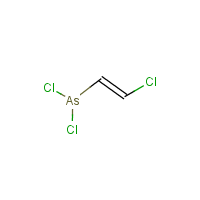Lewisite
Agent Name
Lewisite
CAS Number
541-25-3
Formula
C2-H2-As-Cl3
Major Category
Toxic Gases & Vapors

Synonyms
(2-Chloroethenyl)arsonous dichloride; 1-Chloro-2-di-chloroarsinoethane; 2-Chlorovinyldichloroarsine; Arsine, (2-chlorovinyl)dichloro-; Chlorovinyl dichloroarsine; Chlorovinylarsine dichloride; Dichloro(2-chlorovinyl)arsine; Lewisite (L-1); Lewisite (arsenic compound); Lewisite 1; beta-Chlorovinylbichloroarsine; beta-Chlorovinyldichloroarsine; Arsonous dichloride, (2-chloroethenyl)-; Arsonous dichloride, As-(2-chloroethenyl)-; [ChemIDplus] UN2810
Category
Chemical Weapons
Description
Pure: Colorless odorless liquid; Impure: Brown with an odor like geraniums; [U.S. Army ECBC MSDS]
Sources/Uses
Chemical warfare;
Comments
Like mustard, it damages the eyes, skin, and lungs; however, Lewisite causes immediate pain; it causes redness in 15-30 minutes and blisters within several hours after exposure to the liquid. Unlike mustard, it does not cause immunosuppression. British anti-Lewisite (BAL) is an antidote if used soon after exposure. Lewisite is extremely irritating to the eyes and respiratory tract. High doses can cause pulmonary edema. It can cause hypotension and shock. It may cause hemolytic anemia. [ccc.apgea.army.mil] Lewisite can injure capillaries leading to extravasation of fluid, hypovolemia, and shock. Blood tests may show leukocytosis and the chest x-ray pulmonary edema. [Weinstein, p. 138] Contact with skin or eyes causes immediate pain and lachrymation, with maximum effects at 4-8 hours post-exposure; Vapor exposure (60-330 mg/m3) causes skin discoloration and blistering with maximum effects at 36-48 hours post-exposure; Concentrations of 10 mg/m3/15min causes inflammation of eyes and swelling of eyelids; Inhalation of 500 mg/m3/5min is potentially lethal; Severe exposure may cause pulmonary edema, respiratory failure, liver necrosis, arsenic poisoning, and blindness; [HSDB] See "Arsenic" and the linked occupational diseases.
Reference Link #1
Biomedical References
Exposure Assessment
TIH
Yes
Vapor Pressure
0.58 mm Hg
Lethal Concentration
LCLo (human) = 6 ppm/30min
Explanatory Notes
VP from HSDB;
Adverse Effects
Anemia
Hemolytic anemia
Lachrymator
Yes
Toxic Pneumonitis
Yes
Hepatotoxin
Hepatoxic (a) from occupational exposure (secondary effect) or (b) in animal studies or in humans after ingestion
Dermatotoxin
Skin burns
Diseases, Processes, and Activities Linked to This Agent
Diseases
Occupational diseases associated with exposure to this agent: